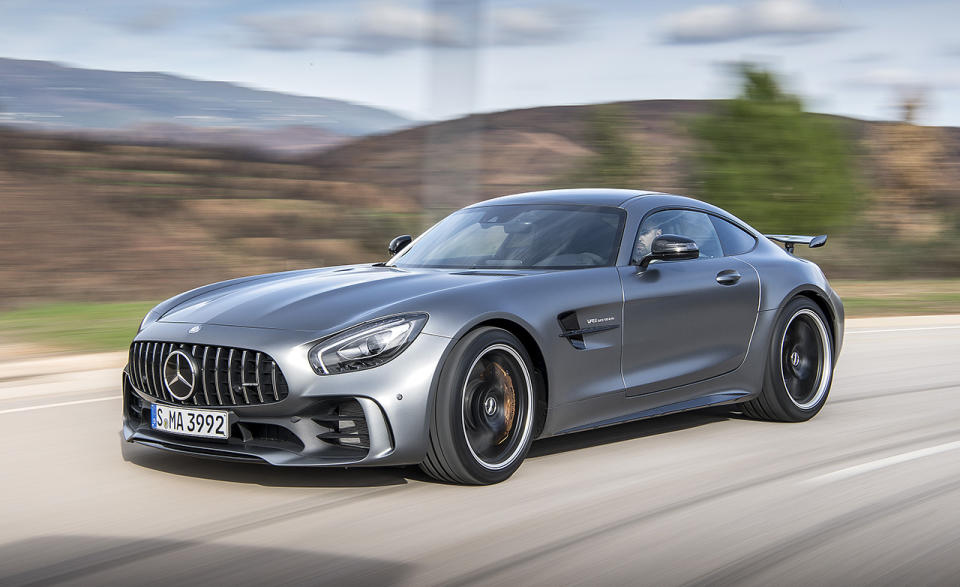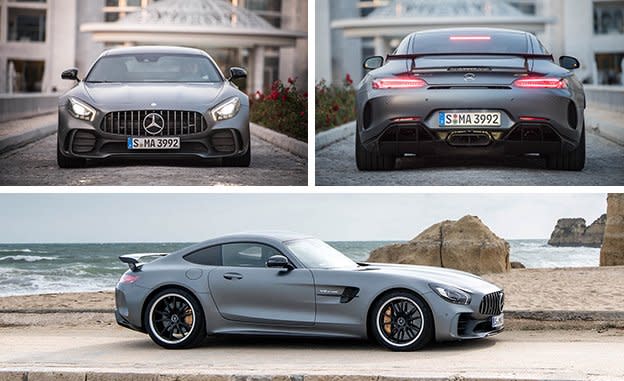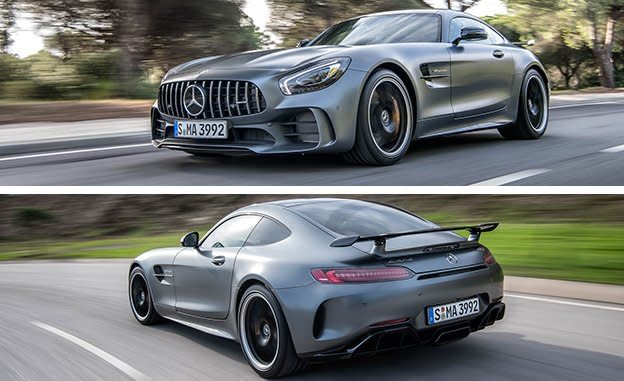2018 Mercedes-AMG GT R

If there’s one thing that’s not in short supply at AMG, it’s confidence. Tobias Moers, Mercedes-AMG’s chairman and CEO, told us in no uncertain terms to compare the latest version of the brand’s sports car, the GT R, against the Porsche 911 GT3 RS. “Our car is faster,” he said. And when we asked where, the reply was as abrupt as it was unequivocal: “Everywhere.”
Of course, the 4.0-liter GT3 RS is, unfortunately, no longer an active concern: Despite a few examples that remain on dealer lots, it exists only in the past tense. It’s also considerably less powerful and hundreds of pounds lighter than the track-focused GT R. But those differences don’t stop it from being one of the best track cars ever produced, possibly even the very best. These, then, are fighting words.

Don’t confuse the GT R as a GT S model with its boost cranked up. This is a comprehensive revision to make an already fast car even faster in every way. And it works. The full depth of the revamp became evident on our ride with five-time DTM champion Bernd Schneider around the Algarve International Circuit near Portimão, Portugal. A freakish blend of blind crests, off-camber torture turns, and vanishing braking zones, Portimão isn’t a beginner’s racetrack. But it’s Schneider’s unconventional technique that lets the car shine.
Entering an off-camber 180-degree left, he smashes the brake pedal with his left foot. With the car writhing for longitudinal grip, he cranks the wheel in a seemingly vain attempt to dive toward the apex. But, somehow, it works. ABS working overtime, and with his right foot still partially into the throttle to improve response, the GT R turns. As the apex nears, Schneider releases the brake and pins the throttle, relying on the GT R’s advanced traction control to deliver torque to the ground. There is no subtlety here. No consideration is given to separating braking and steering inputs. Rather, this is a full-commitment reliance on technology. And to do so requires stones. The GT R delivers the former. The latter are up to you.
Schneider, who steps in only for high-level track development at AMG, reveals a level of progress we’ve not seen elsewhere. The left-foot braking and brake/throttle overlap abilities baked into the GT R’s powertrain- and stability-control calibration demonstrates that the team at AMG isn’t just fooling around with track driving. They’re seeking speed, convention be damned.

Revised V-8
AMG is a longtime purveyor of excess horsepower, but its greatest strength still lies in its engines, however, here taking the form of a twin-turbocharged 4.0-liter V-8. At 577 horsepower and 516 lb-ft of torque, the GT R’s dry-sump powerplant produces 74 horsepower and 37 lb-ft of torque more than the GT S model. Boost, which increases from 17.4 to 19.6 psi, is a big part of that equation. A drop in compression from 10.5:1 to 9.5:1 helps accommodate the boost increase. The two BorgWarner turbos housed in the engine’s valley get bigger compressor wheels, and the cylinder heads’ exhaust ports are milled to improve flow. But the engine changes are just the beginning.
The transmission remains the same basic seven-speed dual-clutch automatic used in the GT and GT S models. It’s a relatively compact transaxle that incorporates an electronically controlled limited-slip differential and is located between the rear wheels. In the GT R, however, its ratios are altered; first gear is taller, seventh is shorter, and the final drive is shorter as well, changing to 3.88:1 versus the GT S’s 3.67:1 ratio. The result overall is a taller first gear—the goal was that it could now be used in tight corners—and shorter ratios in second through seventh. Stealing a trick from Porsche, AMG cuts fuel delivery while keeping the throttles open to avoid stalling the turbos when the driver lifts off the accelerator. The transmission bangs between gears with zero hesitation and satisfying popping on downshifts.
Lightweight Tech
Considerable expenditure was made to lighten the GT R through the use of advanced materials. However, the addition of proprietary hardware such as movable aerodynamic elements and rear-wheel steering diminish the net reduction to a claimed 33 pounds. Expect the GT R to hit the scales at about 3650 pounds—not light for a car toeing the line with the best from Weissach. It’s not for lack of effort. The roof, rear wing (which is manually adjustable), automatic front splitter, rear diffuser, and front fenders are carbon fiber, as are three underbody braces. The torque tube connecting the engine and transaxle is a one-piece carbon-fiber unit that saves 17.6 pounds over the aluminum part in the GT S. Carbon-ceramic brake rotors (15.8 inches front, 14.2 inches rear) with six-piston front calipers are optional. Flaps in the lower grille automatically open and close to alter cooling and change the GT R’s aero profile but also add weight, cost, and complexity. Even so, at 124 mph, there is neither aerodynamic lift nor downforce in front, and the car produces 110 pounds of downforce on the rear axle. High-speed stability, which eases the driving task, was a key goal according to Moers.

Those carbon front fenders accommodate a 1.8-inch-wider front track while the rear increases 2.3 inches. Forged wheels increase one inch in width relative to the GT S (19 by 10 inches in front, 20 by 12 at the rear). Confirming its status as a track special are Michelin Pilot Sport Cup 2 tires, the same rubber available on the Chevrolet Corvette Z06, although in both cases this French rubber is custom-tuned to its application.
Tune It Yourself
Adjustability is a key component of the GT R’s personality. Height-adjustable coil-over springs at every corner allow for ride-height tweaks and chassis balancing should GT R owners be so ambitious. Inside, the chassis and powertrain response can be altered using five drive modes: Individual, Comfort, Sport, Sport Plus, and Race. Separate buttons for the dampers (two settings), exhaust, manual gearchange lockout, and stability control allow fine-tuning even within a particular mode. The addition of a nine-position knob in the center of the dash to manage the traction-control system is the most important tunability change from the GT and GT S models.
Our hour or so of seat time was as marred by unfamiliarity with the track as it was by jet lag. Even so, several observations are clear. Otherworldly braking is the GT R’s greatest asset. Not just braking, but braking while turning—the technique Schneider demonstrated and endorses as fastest. The addition of rear-wheel steering, which works in step with a quicker-ratio rack up front, relieves the front tires of some of the turning work at a time when they most need it—during heavy braking. Below 62 mph, the rear wheels turn opposite the fronts, and above that speed, they turn in the same direction. A new calibration for the electronically controlled differential aids in controlling yaw during heavy braking, and the stability-control system is online during deceleration, even when you’ve switched it off. It’s not, however, an aggressive buzzkill.

The adjustable traction control, activated by switching off the stability control, lacks the elegance of other systems. It mitigates unintended oversteer well, but its abrupt correction of even modest slip angles sometimes interrupts the flow of a well-executed corner exit. We never tried its least intrusive setting, however, so a final verdict will have to wait. Chevy’s Performance Traction Management offers similar control but with subtler intervention, allowing the tail to slightly step out before discreetly reeling it back in.
The GT R goes on sale in mid-2017. By then, the 911 GT3 RS will have further receded into the memory banks, and attention is likely to be focused on the 2018 Corvette Stingray ZR1, which is currently sprouting wings in spy photos. That’s probably where Moers should aim his targeting reticles.
That the GT R will prove itself to be among the world’s quickest track cars isn’t really in question. Speed, however, isn’t the sole measure of a great driver’s car. Driving fulfillment is a product of many factors—some tangible, some not. Control ranks high on our list, though, and the GT R offers a level we’ve not experienced elsewhere. Its size and weight are undeniable downsides. And its driving position, which is close to the rear axle, amplifies every degree of slip angle, making it feel even bigger than it actually is. But being big often goes hand in hand with being bold, undeniably a character trait of this most special of AMGs.
Specifications >
VEHICLE TYPE: front engine, rear-wheel-drive, 2-passenger, 2-door hatchback
ESTIMATED BASE PRICE: $199,000
ENGINE TYPE: twin-turbocharged and intercooled DOHC 32-valve V-8, aluminum block and heads, direct fuel injection
Displacement: 243 cu in, 3982 cc
Power: 577 hp @ 6250 rpm
Torque: 516 lb-ft @ 1900 rpm
TRANSMISSION: 7-speed dual-clutch automatic with manual shifting mode
DIMENSIONS:
Wheelbase: 103.5 in
Length: 179.2 in
Width: 79.0 in Height: 50.6 in
Cargo volume (C/D est): 12 cu ft
Curb weight (C/D est): 3650 lb
PERFORMANCE (C/D EST):
Zero to 60 mph: 2.9 sec
Zero to 100 mph: 6.7 sec
Standing ¼-mile: 11.1 sec
Top speed: 197 mph
FUEL ECONOMY (C/D EST):
EPA combined/city/highway: 17/15/21 mpg

 Yahoo Autos
Yahoo Autos 